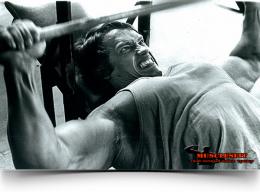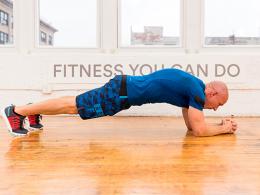Pull-ups: how to learn pull-ups from scratch and pull-up tips
16.04.2018 14.02.2019
Pull-ups are one of the key bodyweight exercises that are important for developing upper body muscles. The ability to pull up is a good measure of your fitness and strength training.
In this article, we will consider an important issue: how to learn to pull up from scratch on the horizontal bar for men and women, as well as analyze the technique of pull-ups and useful tips on how to learn to pull up.
Why do you need to learn to pull up on the horizontal bar?
Everyone can learn how to pull up on the horizontal bar, regardless of whether there was a successful pull-up experience in the past. This exercise helps to simultaneously work on all the muscles of the arms and torso: pectoral muscles, muscles of the back and shoulders, biceps and triceps. At the same time, to perform pull-ups, you only need a horizontal bar, which is easy to install at home or find on the sports ground. Pull up is considered most effective exercise with your own body weight to develop the muscles of the arms and back.
Benefits of pull-ups:
- Pull-ups on the horizontal bar develop the muscles of the upper body and form a beautiful relief of the muscles of the arms, shoulders, chest and back.
- Regular pull-ups help strengthen joints and ligaments.
- Pull-ups can be done at home or on the street, you only need a horizontal bar or crossbar.
- Pull-ups strengthen the core muscles and help keep the spine healthy and functional.
- The ability to pull yourself up on the horizontal bar is a good demonstration of your physical strength and endurance.
- If you learn how to pull yourself up on the horizontal bar, then it will be easier for you to master such exercises as a handstand, as well as exercises on bars and rings.
Many people wonder how quickly you can learn to pull up from scratch? It depends entirely on your fitness and training experience. If you used to know how to pull up, then it will be much easier for your body to “remember” the load than to learn a fresh skill from scratch. Usually 3-5 weeks are enough to start pulling up on the horizontal bar at least a few times. If you have never pulled up before, then you can learn how to perform this exercise in 6-9 weeks.
What can interfere with pull-ups:
- Overweight and overweight
- Weak upper body muscles
- Lack of pull-up practice in the past
- Unused technique
- Attempt to perform pull-ups without preparatory work
- Weak functional training
- Ignorance about lead-up exercises for pull-ups
In order to learn how to pull up from scratch, you must prepare not only your major muscle groups, but also your stabilization muscles, joints, and ligaments. Even if you have enough strength to perform barbell rows for the back or dumbbell lifts with a lot of weight, it is not at all certain that you will be able to pull yourself up. That is why it is not enough just to pump up the main muscle groups that are involved in pull-ups. (arms and latissimus dorsi). You will need fully prepare your body to pull-ups with the help of lead-up exercises - they will be discussed below.
Contraindications for doing pull-ups:
- Scoliosis
- Herniated discs
- Osteochondrosis
- Spinal protrusions
- arthrosis
In some cases, regular pull-ups or even just hanging on the horizontal bar help get rid of spinal diseases. But if you have already If you have back problems, then before you start pulling up, be sure to consult your doctor. Exercises on the horizontal bar can aggravate already existing diseases of the spine.
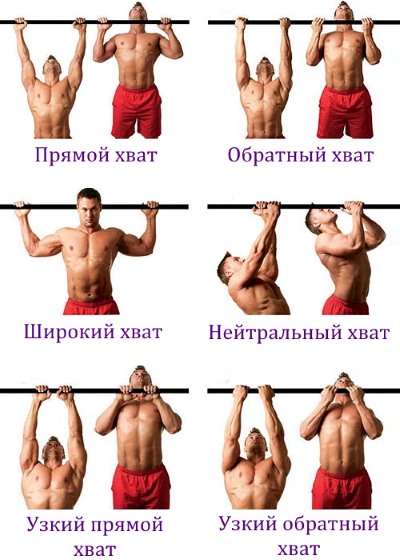
There are several types of pull-ups depending on the grip of the hands:
- Direct grip. In this case, the palms look in the opposite direction from you. Such a grip is considered the most preferable, when performing the main load goes to the latissimus dorsi and shoulders.
- Reverse grip . In this case, the palms and wrists are facing you. It is easier to pull yourself up with such a grip, since the biceps take on most of the load, which help to pull the body to the horizontal bar.
- Mixed grip . In this case, one hand holds the horizontal bar with a direct grip, and the other with a reverse grip. Such pull-ups can be performed when you have already mastered both grips and want to diversify the load on the muscles. Be sure to change hands when doing these pull-ups.
- Neutral grip . In this case, the palms of the hands look at each other. Pull-ups with a neutral grip give an accentuated load on the lower region of the latissimus dorsi.
At first, you can only pull yourself up with a reverse grip, if it is easier for you. But gradually try to master pull-ups with both direct and reverse grips to work out the maximum muscle group.
Depending on the position of the arms, pull-ups are:
- Narrow grip: the maximum load falls on the hands (the easiest pull-up option).
- Wide grip : the maximum load falls on the latissimus dorsi (the most difficult version of pull-ups). It is not recommended to combine a wide and reverse grip at the same time, this can damage the ligaments.
- With classic grip (shoulder-width apart): the load is distributed proportionally, so this is the most preferred type of pull-ups.
Different types of grip and hand placement allow you to work all muscle groups of the upper body, using in fact one exercise with your own body weight - pulling up. By learning how to pull yourself up, you can improve your body even without using free weights and simulators. At the same time, you can always complicate this exercise: just pull yourself up on one arm or use weights (backpack, belt).

How to properly pull up on the horizontal bar
Before moving on to a detailed diagram of how to learn how to pull up from scratch for men and women, let's focus on proper pull-up technique .
So, for classic pull-ups, place your hands on the horizontal bar at shoulder width or slightly wider than shoulder width. The shoulder blades are brought together, the body is fully extended, the stomach is tucked up, the shoulders are lowered, the neck is not pressed into the shoulders, the fingers firmly grasp the crossbar. As you inhale, slowly pull your body up, your chin should be above the bar. Hold for a fraction of a second and as you exhale, lower your body to its original position.

Pulling up is performed slowly at each stage of the movement: both on the ascent and on the descent. You should feel the maximum tension in the muscles of the arms and back, you should not make unnecessary movements, trying to simplify your task. In terms of effectiveness for the muscles, it is better to perform one technical pull-up than five non-technical ones. You can try pulling up with any kind of grip, first choose the easiest option for you.
Be sure to follow the correct breathing during pull-ups, otherwise your muscles will not receive enough oxygen, which means their strength and endurance will decrease. Breathe in deeply through your nose (when lifting the body to the crossbar) and exhale through your mouth in relaxation (when relaxing the arms and lowering the torso).
What to do it is forbidden while pulling up:
- Rock and twist the body
- Make jerky and sudden movements
- Arch your lower back or arch your back
- Hold breath
- Press your head into your shoulders and strain your neck

Step-by-step instructions on how to learn to pull up from scratch
In order to learn how to pull up from scratch, you need to perform a series of leading exercises that will prepare your body for the load. By practicing these exercises regularly, you will be able to master pull-ups on the crossbar, even if they have never been done before and even if you don't believe in yourself. These exercises are suitable for both men and women, the degree of load is regulated independently. Leading exercises will help you strengthen not only the muscles, but also the ligaments and joints.
Thank you youtube channels for the gifs: OfficialBarstarzz, Abnormal_Beings, Colin DeWaay, Xenios Charalambous, Matt Cama 2.
1. Exercises with additional weight for muscles
Exercises with additional weight will help you strengthen the latissimus dorsi and biceps, which are involved in pull-ups. You can use dumbbells instead of a barbell. Perform each exercise in 3-4 sets, 8-10 reps. Rest 30-60 seconds between sets. Choose a weight so that the last exercises in the approach are performed at maximum effort.

If you do not have access to machines and free weights, then you can immediately start the exercises on the horizontal bar, which are presented below, to prepare for pull-ups.
The Australian pull-up is the perfect exercise to help you learn how to pull up from scratch. To perform it, you will need a low crossbar, approximately at waist level. (in the gym you can use the bar in the Smith machine). Note that during the Australian pull-up, your body must remain straight from heels to shoulders. You can not bend down and arch up, the whole body is tense and taut.
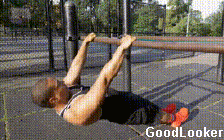
The most important advantage of the Australian pull-up is that it will feasible for absolutely everyone, since its complexity is determined by the angle of inclination. The more vertical your body is, the easier it is to perform the exercise. Conversely, the more horizontal the body is, the more difficult it will be to perform the Australian pull-up. Also, the load depends on the height of the crossbar - the lower it is, the more difficult it is to pull up.
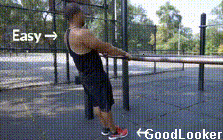
When performing Australian pull-ups, we recommend changing grips: wide grip, shoulder-width grip, narrow grip. This will allow you to effectively work all muscle groups from different sides and adapt to pull-ups. You can perform 15-20 repetitions with different types of grips.
3. Pull-ups on loops
If you don’t have a bar to perform Australian pull-ups or want to better prepare for the classic pull-ups on the horizontal bar, then you can pull up on loops. The gym usually always has such devices, but at home there is a good alternative - TRX loops. This is a very popular simulator for training with your own body weight and the development of all muscle groups. With TRX, you can learn pull-ups even faster.

4. Leg-supported pull-ups
Another pull-up exercise is pull-ups on the low bar with your feet on the floor. To practice this exercise, it is not necessary to have a low crossbar; you can put a box or chair under a regular horizontal bar and fully lean on it with your feet. It is much easier than regular pull-ups, but it is ideal as a muscle preparation.
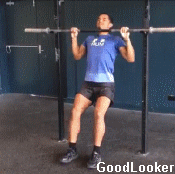
5. Pull-ups with a chair
A slightly more difficult version of the previous exercise is pulling up with support on a chair with one leg. At first, you can fully lean with one foot on the chair, but gradually try to hold your weight with the muscles of your arms and back, leaning less and less on the chair.
Another simple but very effective exercise that will help you learn how to pull up from scratch is hanging on the horizontal bar. If you cannot hang on the horizontal bar for at least 2-3 minutes, then it will be difficult for you to pull yourself up. Hanging on the horizontal bar is useful for strengthening the wrists, developing the muscles of the back and straightening the spine. Also, this exercise will help the ligaments get used to the weight of your body.
Please note that when hanging on the horizontal bar, the shoulders should be lowered down, the neck extended and not pressed into the shoulders. The body should remain free, the spine extended, the stomach tucked up. You can perform the exercise in several approaches for 1-2 minutes.
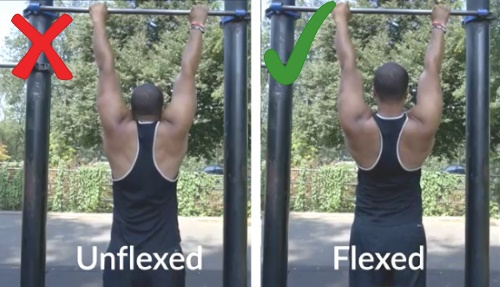
If you calmly hang on the horizontal bar for several minutes, then you can proceed to the next stage - pulling up with (expander). One end of the rubber band is attached to the crossbar, and the other fixes the leg. The expander will take on some of your weight and pull your body up. Rubber loops can be purchased on Aliexpress, details with product links in the second part of the article. By the way, this type of expander is suitable not only for pull-ups, but also for many strength exercises.

8. Pull-ups with a jump
Another pull-up exercise that will help you learn how to pull up from scratch is the jump pull-up. If you've never done a pull-up before, you may not be able to do it, so it's best to practice the above exercises first. If your muscle strength allows you to perform a jumping pull-up, then this exercise will perfectly prepare you for regular pull-ups.
Its essence is as follows: you jump as high as possible to the horizontal bar, hold yourself for a few seconds and slowly go down. This could be one of the options. negative pull-up.

9. Negative pull-ups
Any exercise has two phases: positive (when muscle tension occurs) and negative (when muscles relax). If you can't handle both phases of a pull-up yet (that is, pull up on the horizontal bar and go down), then perform only the second phase of the exercise or the so-called negative pull-up.
For the negative pull-up, you need to pause in a bent-arm position over the bar (as if you've already done a pull-up), using a chair or a partner. Your task is to linger at the top as long as possible and then go down very slowly, tensing the muscles of the arms and back as much as possible. The negative pull-up is another great exercise to help you learn how to pull up from scratch.

The number of repetitions in last three exercises depends on your capabilities. The first time, you will probably do only 3-5 reps in 2 sets. But with each lesson you need to increase the results. Aim for these numbers: 10-15 reps, 3-4 sets. Rest 2-3 minutes between sets.
Pull-ups for beginners
We offer you a ready-made scheme of how to learn to pull up from scratch for men and women. The scheme is universal and suitable for all beginners, but you can adapt it to your abilities by slightly lengthening or shortening the plan. Train 2-3 times a week. Before doing pull-ups, be sure to warm up and at the end stretch the muscles of the back, arms, chest:
Ideally, start your workout with exercises for the back. (rod pull, vertical and horizontal pull), but if this is not possible, you can only train on the horizontal bar. If you are faced with the task of learning how to pull yourself up on the horizontal bar from scratch in a short time, then you can do it 5 times a week. But not more often, otherwise the muscles will not have time to recover and there will be no progress.
The plan below is designed for beginners. If you are already quite an experienced practitioner, then feel free to start with 3-4 weeks. The scheme indicates only the approximate number of repetitions, it is always better to focus on your physical capabilities. Be sure to keep track of how many reps and sets you've done so you can keep track of your progress. You can rest between sets for 2-3 minutes or dilute pull-ups with other exercises.

First week:
- 5-8 reps 3-4 sets
Second week:
- Leg-supported pull-ups: 10-15 reps 3-4 sets 30-60 seconds in 2 sets
Third week:
- 5-8 reps 3-4 sets45-90 seconds in 3 sets
Fourth week:
- 10-15 reps 3-4 sets90-120 seconds in 3 sets
Fifth week:
- 3-5 reps in 2-3 sets 10-15 reps 3-4 sets90-120 seconds in 3 sets
Sixth week:
- 3-5 reps in 2-3 sets
- Pull-ups with a chair (leaning on one leg): 5-7 reps in 2-3 sets
Seventh week:
- Pull-ups with rubber loops: 5-7 reps in 2-3 sets
- Pull-ups with a chair (leaning on one leg): 5-7 reps in 2-3 sets
Eighth week:
- Negative pull-ups: 3-5 reps in 2-3 sets
- Pull-ups with rubber loops:
Ninth week
- Jumping pull-ups: 3-5 reps in 2-3 sets
- Pull-ups with rubber loops: 7-10 reps in 2-3 sets
tenth week
- Classic pull up: 2-3 reps in 2-3 sets
- Jumping pull-ups: 3-5 reps in 2-3 sets
You can speed up the training plan if you are seeing more progressive results than indicated in the scheme. Or vice versa, slow down the rate of increasing the number of repetitions, if you are not yet able to achieve the desired result. Don't worry, sooner or later you will reach your goal!
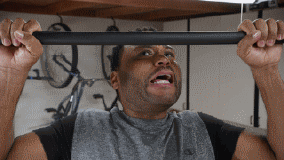
1. Do not make jerky and sudden movements during pull-ups. Exercises should be performed only due to muscle strength, do not simplify your task with swaying and inertia.
2. Don't force yourself on the horizontal bar, especially if you're trying to learn how to pull up from scratch. Hurried fast movements and excessive load can damage the joints and ligaments. Always aim to improve the quality of your exercise, not the quantity.
3. The lower your initial weight, the easier it is for you to learn how to pull yourself up on the horizontal bar from scratch. Therefore, work on pull-ups should go in parallel with the process of getting rid of excess fat.
4. During exercise, do not hold your breath, otherwise it will lead to rapid fatigue.
5. Whatever lead exercise you do on the horizontal bar or crossbar, try to gradually increase the number of repetitions and approaches. For example, if at first you can only do 3-4 Australian pull-ups, then gradually increase their number to 15-20 repetitions and complicate the angle of inclination.
6. In order to progress in the quantity and quality of pull-ups, you should perform not only lead-up exercises, but also train the whole body. Work with dumbbells, barbells, machines and push-ups for the best results.


